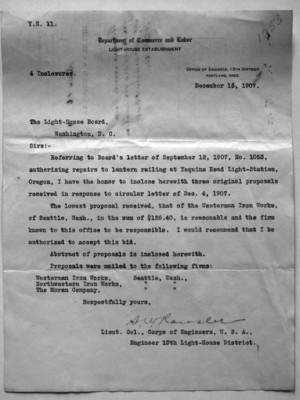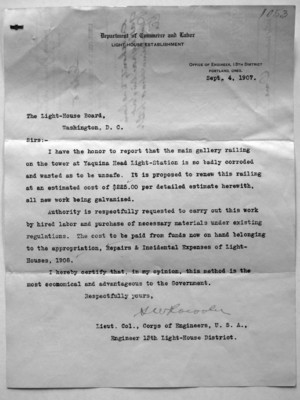Pages That Mention Engineer
1870-73 Lighthouse Board Annual Reports
51
1873. July 14.
From Naval Secretary Comdr. J. G. Walker To Major H. M. Robert. Corps Engineers.
Sir: Herewith enclosed please find a copy of a letter from the Honorable the Secretary of the Treasury respecting the basis of currency upon which payments are to be made for services rendered and materials procured withinthe United States for the Government.
_______________________________________
July 22.
From Acting Engineer Secretary Major O. M. Poe. To Major H. M. Robert. Corps Engineers.
Sir: I herewith enclose for payment a bill for advertising in the "Alta California" Boilers for Fog Signals, approved by the Secretary of the Treasury and amounting to $8.75.
________________________________________
July 25.
From Acting Engineer Secretary Major O. M. Poe. To Major H. M. Robert. Corps Engineers.
Exhibit Foulweather light August 20th, and thereafter.
________________________________________
July 25.
From Acting Engineer Secretary Major O. M. Poe To Major H. M. Robert. Corps Engineers.
Sir: Herewith enclosed are transmitted three copies of contract duly approved made with James A. Robb for completion of Cape Foulweather Light-House, Oregon. One copy for file in the Engineer's office, one for the Superintendent of Construction, and one for delivery to the contractor.
52
1873.
to the position of Clerk in your office as Engineer of the 13th Light House District, you will please have delivered to him.
_______________________________________
Nov. 20.
From Engineer Secretary Major G. H. Elliot. To Major N. Michler. Corps Engineers.
Sir: The Board at its last meeting directed that the District officers report as to the expediency of discontinuing the light at Yaquina, Oregon. Your views concerning the proposition are requested for the information and action of the Board.
________________________________________
Nov. 20.
From Engineer Secretary Major G. H. Elliot. To Major N. Michler. Corps Engineers.
Sir: I enclose for your information a copy of a letter from the Honorable the Secretary of War, approving the application of the Board for permission to build a road through Fort Stevens Military reservation to Point Adams, and to state that no action in the premises should be taken until further advice.
Enclosure- see Volume 350, page 100 of Letters Received.
________________________________________
Nov. 26.
From Engineer Secretary Major G. H. Elliot. To Major N. Michler Corps Engineers.
Sir: Herewith please find extracts from Inspection Reports of Light House Stations in your District. Your attention is called to them, and you are requested to make, without delay, such repairs in each case as may be necessary, and especially
Coast Guard District narrative histories 1945
22
to the 350 watt and 750 watt electric lamps of today; this limitation permitted slight variation in the range of the lighted beacons. The lenses increased and magnified the light as they revolved to produce a flashing effect.
Reminicenses of the Lighthouse men who tended these lights during the years when the Northwest was, for the most part, a mountainous wilderness, make interesting listening. Even after the invention of railroads, telephones and the automobile, trips to coastal Light Stations involved travel by boat, stage and horseback. Stage drivers informed passengers before the journey began, that there was no guarantee that the stage could complete the trip, in which event, the traveller made the remainder of his journey on foot. Seasonal rains, washouts, and the miserable conditions of the "roads" (deer trails, or Indian paths) made such stipulations a necessity. Today's brief trip from Bandon to Cape Blanco, Oregon, can be made either way in a fraction of an hour; earlier travellers spent three days; The uncertainty of transportation was illustrated in the following anecdote: An engineer of the Lighthouse Service was called to Destruction Island to repair the boilers. A buoy tender took the engineer to the Island and he requested that the tender return on Friday to pick him up. Friday came - and went; another Friday - no tender; a third Friday - and in the distance the curl of a tender's smoke was seen on the horizon (in those days the smoke trails of the various type ships identified them to the men whose idle hours were spent watching the horizon for the vessels that occasionally appeared there.) When the Master of the tender was admonished for his tardiness, he replied, "You said to come on Friday; isn't this Friday?". Time was of little import.
Life on the Light Stations until the middle thirties was a world of its own. Because of their locations there were no telephone facilities, and commercial electric power did not reach to the outposts. There were generally two keepers and their families assigned to each station and the competition for the most tidy and efficient station among the keepers was keen. A few of the isolated stations at Tillamook Rock, Destruction Island, Cape Flattery, etc. had four or five keepers, one on continuous liberty rotation. With the installation of radiobeacons at many of the stations, it became necessary to bring in commercial electric power or generate power at the station. With electricity available, the i.c.v. light was superceded, the fog signals mechanized, and the comforts of the keeper's dwellings increased. Telephone service or radio-telephone service soon followed as
Correspondence of LH board 1901-1910
9
Y.H. 11. Department of Commerce and Labor LIGHT-HOUSE ESTABLISHMENT 4 Inclosures.
Office of Engineer, 13th District Portland, Oreg. December 16, 1907.
The Light-House Board, Washington, D.C. Sirs: Referring to Board's letter of September 12, 1907, No. 1053, authorizing repairs to lantern railing at Yaquina Head Light-Station, Oregon, I have the honor to inclose herewith three original proposals received in response to circular letter of Dec. 4, 1907.
The Lowest Proposal received, that of the Westerman Iron Works, of Seattle, Wash., in the sum of $128.40, is reasonable and the firm known to this office to be responsible. I would recommend that I be authorized to accept this bid.
Abstract of proposals in inclosed herewith. Proposals were mailed to the following firms:
Westerman Iron Works, Seattle, Wash., Northwestern Iron Works, " " The Moran company, " "
Respectfully yours, S.W. Rocasler ??? Lieut. Col., Corps of Engineers, U.S.A., Engineer 13th Light-House district.
12
Department of Commerce and Labor LIGHTHOUSE ESTABLISHMENT OFFICE OF ENGINEER, 13TH DISTRICT PORTLAND,OREG. Sept. 4, 1907.
The Light-House Board, Washington, D.C.
Sirs: I have the honor to report that the main gallery railing on the tower at Yaquina Head Light-Station is so badly corroded and wasted as to be unsafe. It is proposed to renew this railing at an estimated cost of $225.00 per detailed estimate herewith, all new work being galvanized. Authority is respectfully requested to carry out this work by hired labor and purchase of necessary materials under existing regulations. The cost to be paid from funds no on hand belonging to the appropriation, Repairs & Incidental Expenses of Lighthouses, 1906. I hereby certify that, in my opinion, this method is the most economical and advantageous to the Government. Respectfully yours, SW Rocooler??? Lieut. Col., Corps of Engineers, U.S.A., Engineer 13th Light-House District.




